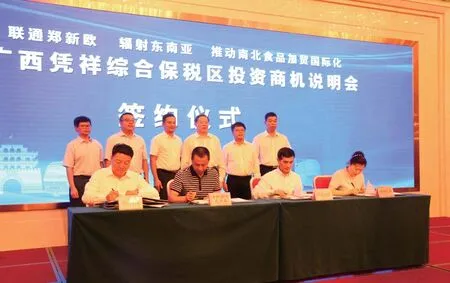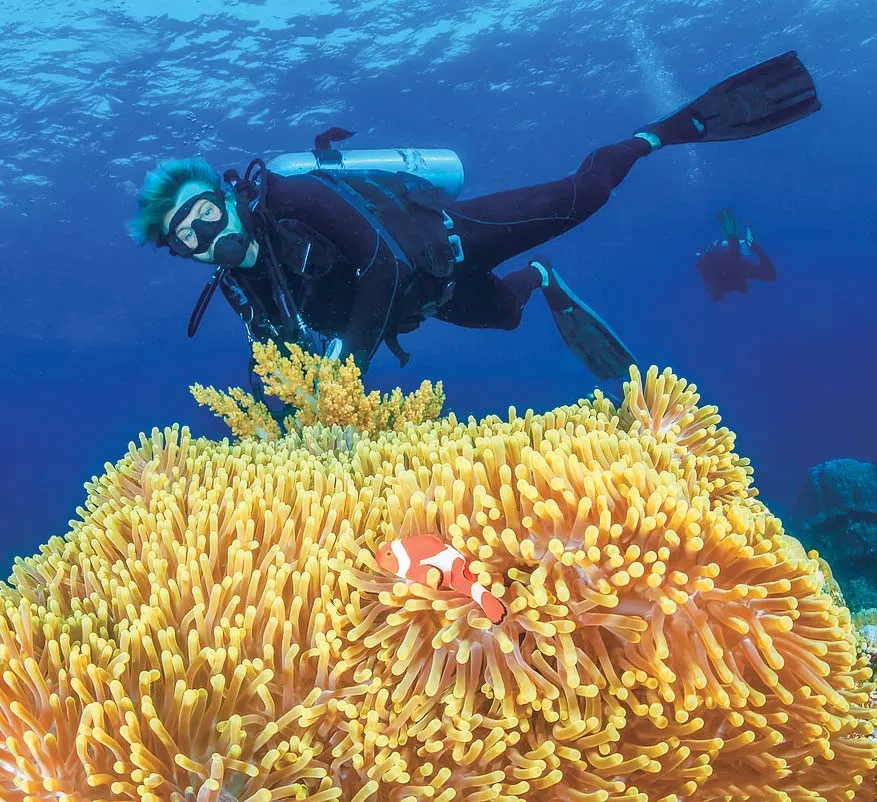凭祥:借势“一带一路”共建互联互通“朋友圈”
2017-07-06李敏军
□ 文/本刊记者 李敏军
凭祥:借势“一带一路”共建互联互通“朋友圈”
□ 文/本刊记者 李敏军

凭祥市人民政府和凭祥综合保税区管委会分别与鲜易控股、万邦物流、万国优品等企业签署了意向合作协议
位于中越边境的凭祥市,往北,有高速公路连通中国内地;往南,通过越南1号公路可直达170公里外的越南河内,进而通达老挝、泰国等东南亚国家。鸟瞰这座北部湾经济区内年轻而富有活力的边境城市,一条连接东南亚距离最短、最为便捷的陆路国际大通道正呈现在眼前,助力凭祥成为“一带一路”上一个耀眼的节点城市。
立足凭祥市独特的区位优势,广西凭祥综合保税区正在这片热土上发光发热,它是中国第一个与境外实现“直接相连”、具有跨境合作背景的综合保税区,拥有广西凭祥重点开发开放试验区、中越凭祥—同登跨境经济合作区、凭祥边境经济合作区等多个国家级平台。依托这些平台,凭祥综合保税区主动向外走,与“一带一路”沿线节点城市加强合作,共同打开走向东盟市场的新大门。
抓机遇 桂豫两地点燃腾飞新引擎
顺势而为,乘势而上。广西凭祥、河南郑州两地正紧握"一带一路"新契机,共商优势互补、合作共赢之路。
2017年6月23日,由广西凭祥综合保税区管委会、凭祥市政府主办的广西凭祥综合保税区投资商机说明会在中国河南省郑州市举办。说明会充分展现了凭祥综合保税区的政策、区位、产业优势;通过就当地企业特点进行分析与商机解读,为郑州企业打开了走向东盟市场的新大门,给企业提供了掘金东盟的新策略。与会嘉宾还就凭祥与郑州的互联互通、重点产业的对接、国际市场的开拓战略等内容进行了对话。会上,凭祥市人民政府与鲜易控股签约,凭祥综合保税区管委会与河南万邦国际农产品物流有限公司、郑州万国优品跨境电子商务有限公司等企业签署了意向合作协议。
当前,凭祥与郑州两地正深度挖掘自身优势和资源,欲开通“郑州经广西凭祥至东南亚的班列”,为两地经济发展注入新活力。
广西凭祥综合保税区常务副主任、凭祥市委书记邱明宏在“郑新欧”班列综合服务中心考察时指出,凭祥综合保税区作为中国—中南半岛经济走廊上的重要节点和中国—东盟陆路国际通道的枢纽,拥有与东盟实现互联互通的陆路通道的优势,官方将调动各方力量来推动东南亚班列的建设工作。
目前,“郑新欧”班列在“一带一路”框架下,由郑州陆港前期规划建设,经阿拉山口和二连浩特两个口岸出(入)境,途经哈萨克斯坦、俄罗斯、白俄罗斯、波兰、德国等国家,中途上、下货物正呈现出多点常态化的发展态势,已经以中国郑州和德国汉堡为核心初步形成双枢纽集疏运格局。凭祥综合保税区与郑州陆港联手合作,将实现中国—中南半岛经济走廊与“一带一路”的有机衔接。
据了解,河南承东启西、连南贯北,是中国重要的综合交通枢纽和物流中心,广西沿海、沿江、沿边,是“一带一路”有机衔接的重要门户,两地长期以来保持着良好合作关系,合作前景广阔,必将共享“一带一路”建设红利,共同谱写桂豫合作新篇章。
拓市场 “黄金通道”让企业贸易更通畅
政府搭台,企业唱戏。广西凭祥正在搭建一个开放的“舞台”。5~6月期间,凭祥综合保税区、海关、检验检疫等部门负责人还赴重庆、江苏昆山等地举办投资商机说明会,就投资商机、海关政策、国检政策等内容进行了分析解读,助力当地电子、机电、食品、电商、物流等企业掘金加速“出海”。
在凭祥综合保税区(重庆)投资商机说明会上,凭祥综合保税区管委会与重庆公路运输(集团)有限公司签订了战略合作框架协议。根据协议,双方将共同加快推进“渝桂新”南向国际大通道建设,共同建设物流合作平台,还将举行“渝桂新”南向国际大通道陆路卡车班列首发仪式,扩大“渝桂新”国际南向大通道的影响力。
在江苏昆山,凭祥综合保税区也以“对接苏桂产业合作需求,打造口岸经济新亮点”为主题举办了投资商机说明会,为当地企业解读“一带一路”规划中的重要优势,挖掘“一带一路”新商机。
据悉,苏桂两地、苏桂与东盟之间,在经济结构上具有较强的发展关联性和互补性,各有优势。与凭祥综合保税区的密切合作,符合江苏昆山市对自身融入“一带一路”的定位和规划,将有效推动昆山与周边地区企业面向东盟的国际化发展。
当前,凭祥综合保税区在良好的区位、政策等优势叠加的作用下,已吸引了越来越多的企业入驻。如马来西亚国际物流品牌捷递(OTL)决定2017年将中国总部从深圳迁入凭祥综合保税区;网络覆盖国内外沿海地区和东盟各国主要港口的大型跨国企业——深圳珉丰集装箱服务公司,将入区建设运营中国—东盟陆路集装箱物流枢纽;富士康“准时达”经多次考察,将入区建设运营绿色物流中心;还有以华泰国际为代表的首批进驻企业业务也呈现迅速扩张的态势。
“凭祥的最大特点是‘边’,最大优势是‘边’。”邱明宏表示,借助得天独厚的区位优势,有关方面力争把凭祥综合保税区建设成广西扩大沿边开放的门户,使凭祥综合保税区成为崇左开放龙头和广西北部湾经济区开放的高地。
·联系编辑:237554216@qq.com

广西凭祥综合保税区投资商机说明会走进重庆,当地企业家对话综保区,深入了解综保区的区位优势和政策优势
In the 2014 Philippine Statistics Authority poverty report, the Filipino fishermen remain the poorest among the nine basic sectors.
The report said that, with 39.2-percent poverty incidence,the fishermen have been living with an average earning of P178 a day, with less to nothing to eat every day.
Despite the country’s vast aquatic and marine resources and the numerous research done by the Filipino scientific community in these areas of discipline, the country has still a long way to go to establish a stable and sustainable fishing community that would not only benefit the economy but especially the fishermen.
According to Dr. Ronald Mendoza, dean of the School of Government of the Ateneo de Manila University, during the Visayas Regional Scientific Meeting held in Cebu City on Wednesday, the conservative monetary value that the marine ecosystems should have contributed to the country’s economy is estimate at US$ 970 billion to US$ 1.5 trillion annually, roughly P 74.6 trillion. The scientific meeting was led by the Department of Science and Technology and the National Academy of Sciences and Technology.
With a huge amount of monetary value it should have contributed, the question remains: How can the Philippines promote economic and environmental sustainability with the inclusion of improving the lives of our fishermen?
Blue economy
One of the biggest marine industries in the country is in tuna. In 2003 the Philippines became the fourth-largest producer of tuna and tuna-like species in the world, yet,Filipinos have been compensated less of what they need to earn.
Records in subsequent years show the tuna sector slowly having been dubbed a “sunset industry”. Filipinos have slowly shied away from it, owing to declining catch.
“You see a multibillion-peso industry like the tuna industry and a lot of poor Filipino working in the industry,” Mendoza said during his talk as he pushed for the growth of a blue economy in the country. “These are the important figures that we must figure out on how to correct the imbalance.”
Mendoza defines “blue economy” as “a version of the green economy made relevant to seas and oceans”.
He said, “What we want out of this [blue economy] is not just the extraction [of fishes], it’s actually the sustainable management of this particular resource.”
The Philippines is the second-largest archipelagic country in the world and has the fifth-longest coastline. It is the center of marine biodiversity as it houses 70 percent of the coral triangle with more than 400 species of corals and over 2,200 species of fish.
It is the 10thcountry in the world’s top fishing nations in a 2014 report from the Food and Agriculture Organization of the United Nations. Yet, with all these numbers, the country’s blue economy lies in a limbo.
The block along the way to blue economy growth
Mendoza said, “The economic footprint of our maritime economy is very small at this point.” Just about 3 percent of GDP and a total employment of a little over 4.35 percent are being projected in this sector. There are two main problems.
First, Mendoza said, there is not enough investment in this sector. He said scientists should not just use science and data but also use economics in communicating with politicians.“Tell them that if we invest in this sector, we can create a lot of jobs,” he said in Filipino.
Second, the country should provide solutions so that scientists could translate the outcome of their research into planning and policy. In an interview with the BusinessMirror, Mendoza said, “The main hindrance is [that despite] all our good science, we are unable to translate them into policy and action”.
He said, “We know a lot, have researched a lot, even foreign countries have already learned and picked up scientific findings from us and have made decisions out of them for their own growth”.
He added: “Those kinds of studies [are the essentials]in making an industry…. If we are able to translate this into business and in the public sector in order for them to sharpen business and policy, that’s where we are missing.”He urged the scientists: “Who will take it forward, right?That is the area where we need to do a better job —translating it more on public policy and on business strategy.”
Philippine blue economy can take the lead in Southeast Asia
“We’re not good in extracting [our resources],” Mendoza told the BusinessMirror, comparing the Philippines to other countries in Southeast Asia that have used technology to create a sustainable maritime industry. “Our neighbors have been investing in heavily protecting [their areas and resources] and managing them well,” he said.
To highlight his point, Mendoza showed two images during his talk where a Filipino boy carries a 95-kilogram (kg)tuna on his shoulders and earns only a little fraction of the sale, while Singapore is into vertical farming of crabs and selling it at a high price of US$ 35/kg.
The use of technology has been a great benefit to countries who have used these to their advantage. Technologies, such as drone and growing marine resources in condominiums through vertical farming, are sustainable.
Mendoza recommended that the Philippines needs to exert more effort to catch less fish, and use the research to attain optimum productivity.
“Technology can improve our efficiency and also our ability to sustain our resource better if we only know how to use it,” he said.
Mendoza told the BusinessMirror the Philippines can always take the lead in terms of blue economy since the country has the advantage.
“Space is not a problem nor are the resources because the coral triangle [which area the Philippines occupies 70 percent] is there with us. This should be at the core of our national development plan.”
“We are not that far,” Mendoza said, emphasizing the innovativeness of Filipinos. “This is more of a challenge for collective action on our part and clear planning and foresight — not just for six years but 50 years.”
Stressing the need for collective action, Mendoza said, “If we don’t do the right thing, we will be left behind.”
He said there is a lot of room for improvement and Filipinos need to realize the amount of work it carries.

A diver is watching a butterfly fish under the sea.
· Source: www.businessmirror.com.ph
PHL Needs Blue Economy for Growth
By Stephanie Tumampos
